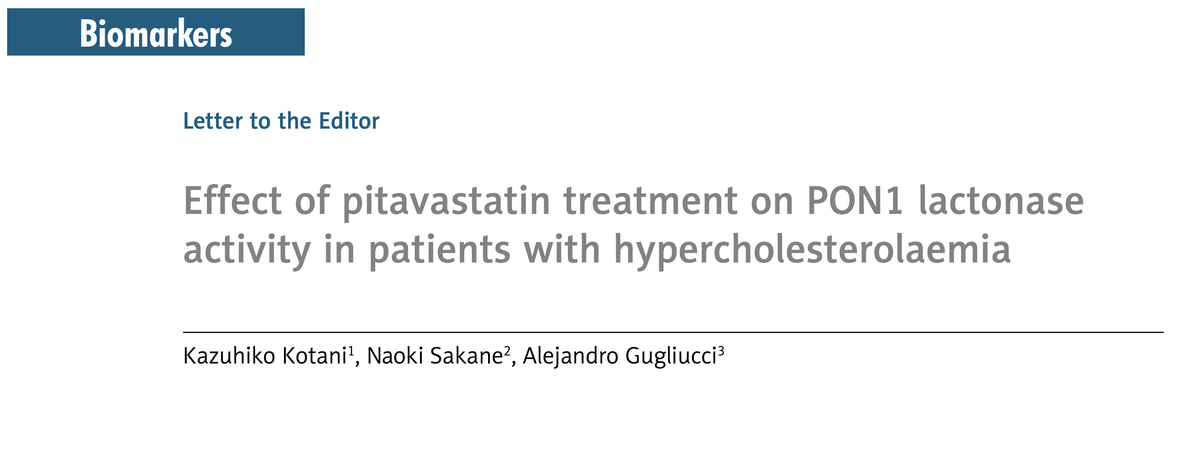Paraoxonase 1 (PON1) is a high-density lipoprotein (HDL)-bound esterase that protects low-density lipoprotein (LDL) and HDL from oxidative stress [1]. Low PON1 activity in the circulation is generally associated with increased risk for the development of atherosclerosis and cardiovascular disease [1]. While PON1 is a promiscuous enzyme, displaying esterase and lactonase activities, the current assay of its activity frequently takes advantage of the former; namely, phenylacetate is used, in which case PON1 activity is expressed as arylesterase activity [1]. On the other hand, much attention has recently been paid to lactones as physiologically relevant substrates that are still under investigation [1, 2].
Familial hypercholesterolaemia (FH) is a genetic disorder characterized by a high level of LDL cholesterol in the circulation, which causes oxidative burden and cardiovascular events [3]. While measuring PON1 activity would make sense and might be expected to contribute to assessing the cardiovascular disease risk in FH, a limited number of studies have examined serum PON1 activities in FH [4, 5], and the results have been inconsistent: one study using arylesterase reported low activities of PON1 [4], while another reported no marked difference in the activity of homocysteine thiolactonase [5] in patients with FH and controls. Therefore, to provide further insights into this issue, the present study investigated PON1 arylesterase and lactonase activities in patients with FH.
A total of 20 patients with FH (age: 58 ±6 years, men: n = 8 (40%), LDL cholesterol: 5.2 ±0.7 mmol/l) and 17 non-FH controls (age: 64 ±10 years, men: n = 7 (40%), LDL cholesterol: 3.2 ±0.6 mmol/l) were enrolled in the study. We excluded those with acute-phase disease conditions. The Institutional Ethics Committee approved the study, and the subjects provided their informed consent.
FH was clinically diagnosed in cases with hyper-LDL-cholesterolaemia, xanthomas, or a family history of premature coronary artery disease, as described in the guideline [6]. In fasted blood samples, the levels of lipids, such as cholesterol and triglycerides, were enzymatically determined. Serum PON1 arylesterase activity was kinetically determined using phenylacetate by recording absorbance changes at 270 nm [2]. Similarly, PON1 lactonase activity was kinetically determined using 5-(thiobutyl) butyrolactone by recording absorbance changes at 405 nm [2]. These values were measured with in-house assays.
A t-test and χ2 test were used between the groups, as well as a general linear model analysis for the individual PON1 activities, after adjusting for the age, gender, and HDL cholesterol. Data are shown as the mean ±standard deviation except for triglycerides (because of the skewed distribution), which are shown with the median (interquartile range). A p-value of < 0.05 was considered significant.
Compared to controls, the patients with FH showed similar levels to controls for HDL cholesterol (1.5 ±0.4 mmol/l in FH vs. 1.7 ±0.4 mmol/l in controls; p = 0.24) and triglycerides (1.3 (1.0–1.9) mmol/l in FH vs. 1.0 (0.9–1.6) mmol/l in controls; p = 0.29). Those with FH had a lower arylesterase activity (131 ±11 U/l in FH vs. 158 ±16 U/l in controls; p < 0.01) and higher lactonase activity (49 ±10 U/l in FH vs. 40 ±12 U/l in controls; p = 0.02) than controls. Multivariable adjusted analyses also showed significant differences in arylesterase (p < 0.01) and lactonase activity (p = 0.02), independent of HDL cholesterol, between these groups.
Thus, the present study revealed that patients with FH can exhibit a marked difference in PON1 activities from controls. Paradoxically, the arylesterase activity was lower and lactonase activity higher in patients with FH than in controls. This opens a line of inquiry as to which mechanism explains the difference as well as which measurement would enable a better understanding of the use of several PON1 measures in clinical practice for FH.
The result of arylesterase seems to indicate an impaired antioxidant function in FH. This result is in line with the previous finding [4], which indicated that the gene polymorphisms for lowering PON1 activities might be more prevalent in patients with FH than in controls [4]. The present study did not examine such genetic backgrounds; nonetheless, we also think that, regardless of such genetic influences, the result may be partly explained by inactivation (consumption) of PON1 by increased oxidative burden seen in patients with FH [1].
Of interest, the higher lactonase activity in patients with FH appeared to be the opposite of the results for arylesterase. The paradoxical observations among substrates used for measuring PON1 activities have been noted [2]. It may be due to differences in binding pockets at the active sites of PON1, where esterase activity exploits one pocket, and lactonase activity exploits another [2]. The active site has a complex versality, where multiple amino acid residues share the same functions while others are specific [2]. In agreement with the current belief that the lactonase activity is the physiological one, one plausible explanation for our result is that the lactonase activity may be increased in compensatory response to the oxidative burden in patients with FH [1].
We acknowledge the limitations associated with our study. The study population was relatively small, and the cross-sectional design cannot completely determine the causality. It is important to examine the pre-post changes in PON1 activities by lipid-modulating treatment. PON1 molecules are reported to be involved in the functionality of HDL (e.g. macrophage cholesterol efflux) [7]; accordingly, the behaviours of PON1 activities can be observed with HDL functional tests in addition to changes of HDL cholesterol. We must consider many other contributors to PON1 activities (i.e. lifestyle habits) that were not fully evaluated. These points will be addressed in a future work.
In conclusion, patients with FH had low arylesterase activity and high lactonase activity. This provides cautionary information concerning the use of different substrates for measuring PON1 activity in clinical practice on FH. Further research is warranted.



